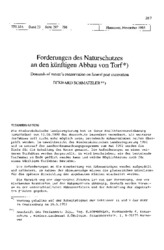Forderungen des Naturschutzes an den künftigen Abbau von Torf
Schmatzler, Eckhard
Schmatzler, Eckhard, 1993: Forderungen des Naturschutzes an den künftigen Abbau von Torf. In: TELMA - Berichte der Deutschen Gesellschaft für Moor- und Torfkunde, Band 23: 287 - 296, DOI: 10.23689/fidgeo-3349.
 |
Dokument öffnen: |
Die Niedersächsische Landesregierung hat in ihrer Koalitionsvereinbarung (SPD/Grüne) vom 12.06.1990 den Moorschutz besonders verankert. Ein weiterer Torfabbau soll nicht mehr möglich sein, bestehende Abbauvorhaben sollen überprüft werden. Im Umweltbericht der Niedersächsischen Landesregierung 1992 und im Entwurf des Landes-Raumordnungsprogramms vom Mai 1992 werden die Ziele für die Erhaltung der Moore genannt. Die Anforderungen an einen weiteren Torfabbau werden dargestellt. Es wird beschrieben, wie der bestehende Torfabbau zu Ende geführt werden kann und welche Möglichkeiten noch für einen künftigen Torfabbau bestehen.
Die Anforderungen an die Erarbeitung von Abbauanträgen werden aufgezählt und erläutert. Im Rahmen der Abbauanträge müssen die planerischen Grundlagen für die spätere Entwicklung der abgebauten Flächen erarbeitet werden.
Die Entwicklung der abgetorften Flächen ist von der Vornutzung, den verbleibenden Resttorfen und der Abbaumethode abhängig. Deshalb werden Hinweise zu den unterschiedlichen Abbauverfahren und der Behandlung der abgetorften Flächen gegeben.
Abschließend wird auf die Aktualisierung des Niedersächsischen Moorschutzprogramms und die im Rahmen dieser Arbeit laufenden Auswertungen und die vorgesehene Darstellung hingewiesen. The government of the state of Lower Saxony in its coalition agreement between the Social Democratic and the Green Party of June 12th, 1990‚put special attendance to peat-bog conservation. Further excavation should not be permitted, existing concessions be examined. In the Environmental Report of Lower Saxony, 1992, and in the draft of the State Land-Use Plan of May, 1992, these claims for peatland conservation can be found as well. Description of the demands for peat excavation in the future is given, in the same time it is indicated how the existing excavation should be brought to an end and which possibilities for further peat winning exist.
The requests necessary for future excavation plans are listed up and explained. With these plans the base for the after-use of the winning areas is laid.
Development of excavated areas is dependent on the pre-use, the remaining peat and the excavation method. Proposals are made with respect to the influence of different excavation measures and treatment of excavation areas.
Finally a description is given on the actualization of the Lower Saxonian Peatland Conservation Act and on studies and research within this program.

